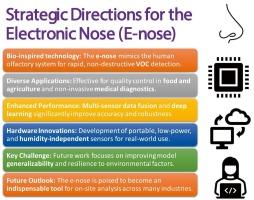电子鼻:分析方法和现实世界应用进展的关键全球综述
IF 4.9
2区 化学
Q1 CHEMISTRY, ANALYTICAL
引用次数: 0
摘要
对最近的文献进行了系统和全面的回顾,强调了电子鼻技术的重大进展和日益成熟。本文综合了从2020年1月到2025年8月的进展,展示了电子鼻从实验室工具到现实世界分析挑战的多功能,非破坏性和成本效益解决方案的演变。该综述围绕四个关键领域进行:它在食品和农业质量中的应用;它在医疗诊断中的应用日益扩大;它在环境和其他监测方面的作用;以及推动其性能的创新方法和技术。研究结果表明,电子鼻,特别是当与高光谱成像等数据融合技术相结合时,通常可以在产品来源追踪和质量控制等任务中实现高精度。在医学诊断方面,电子鼻被证明对非侵入性疾病筛查是有效的,而在环境科学方面,它们提供了实时污染检测的手段。这些实际应用得到了方法论突破的支持,包括采用先进的机器学习算法,如深度学习甚至量子神经网络,这些算法可以增强数据解释和分类。尽管取得了这些进展,但综述指出了未来研究必须解决的关键限制。需要改进模型的通用性,增强传感器对湿度等环境因素的鲁棒性,以及开发自供电和便携式系统是继续研究的关键领域。该论文的结论是,随着这些限制的克服,电子鼻将成为广泛行业快速现场分析不可或缺的工具,从根本上改变我们监测和分析化学特征的方式。本文章由计算机程序翻译,如有差异,请以英文原文为准。

The electronic nose: A critical global review of advances in analytical methods and real-world applications
A systematic and comprehensive review of recent literature highlights the significant progress and growing maturity of electronic nose (e-nose) technology. This paper synthesizes advancements from January 2020 to August 2025, demonstrating the e-nose's evolution from a laboratory tool to a versatile, non-destructive, and cost-effective solution for real-world analytical challenges. The review is structured around four key areas: its applications in food and agricultural quality; its expanding use in medical diagnostics; its role in environmental and other monitoring; and the innovative methodologies and technologies driving its performance. Findings show that the e-nose, particularly when combined with data fusion techniques like hyperspectral imaging, often achieves high accuracy in tasks such as product origin tracing and quality control. In medical diagnostics, e-noses are proving effective for non-invasive disease screening, while in environmental science, they offer a means for real-time pollution detection. These practical applications are supported by methodological breakthroughs, including the adoption of advanced machine learning algorithms, such as deep learning and even quantum neural networks, which enhance data interpretation and classification. Despite these advancements, the review identifies critical limitations that future research must address. The need for improved model generalizability, enhanced sensor robustness against environmental factors like humidity, and the development of self-powered and portable systems are key areas for continued investigation. The paper concludes that as these limitations are overcome, the e-nose is poised to become an indispensable tool for rapid, on-site analysis across a wide range of industries, fundamentally transforming how we monitor and analyze chemical signatures.
求助全文
通过发布文献求助,成功后即可免费获取论文全文。
去求助
来源期刊

Microchemical Journal
化学-分析化学
CiteScore
8.70
自引率
8.30%
发文量
1131
审稿时长
1.9 months
期刊介绍:
The Microchemical Journal is a peer reviewed journal devoted to all aspects and phases of analytical chemistry and chemical analysis. The Microchemical Journal publishes articles which are at the forefront of modern analytical chemistry and cover innovations in the techniques to the finest possible limits. This includes fundamental aspects, instrumentation, new developments, innovative and novel methods and applications including environmental and clinical field.
Traditional classical analytical methods such as spectrophotometry and titrimetry as well as established instrumentation methods such as flame and graphite furnace atomic absorption spectrometry, gas chromatography, and modified glassy or carbon electrode electrochemical methods will be considered, provided they show significant improvements and novelty compared to the established methods.
 求助内容:
求助内容: 应助结果提醒方式:
应助结果提醒方式:


